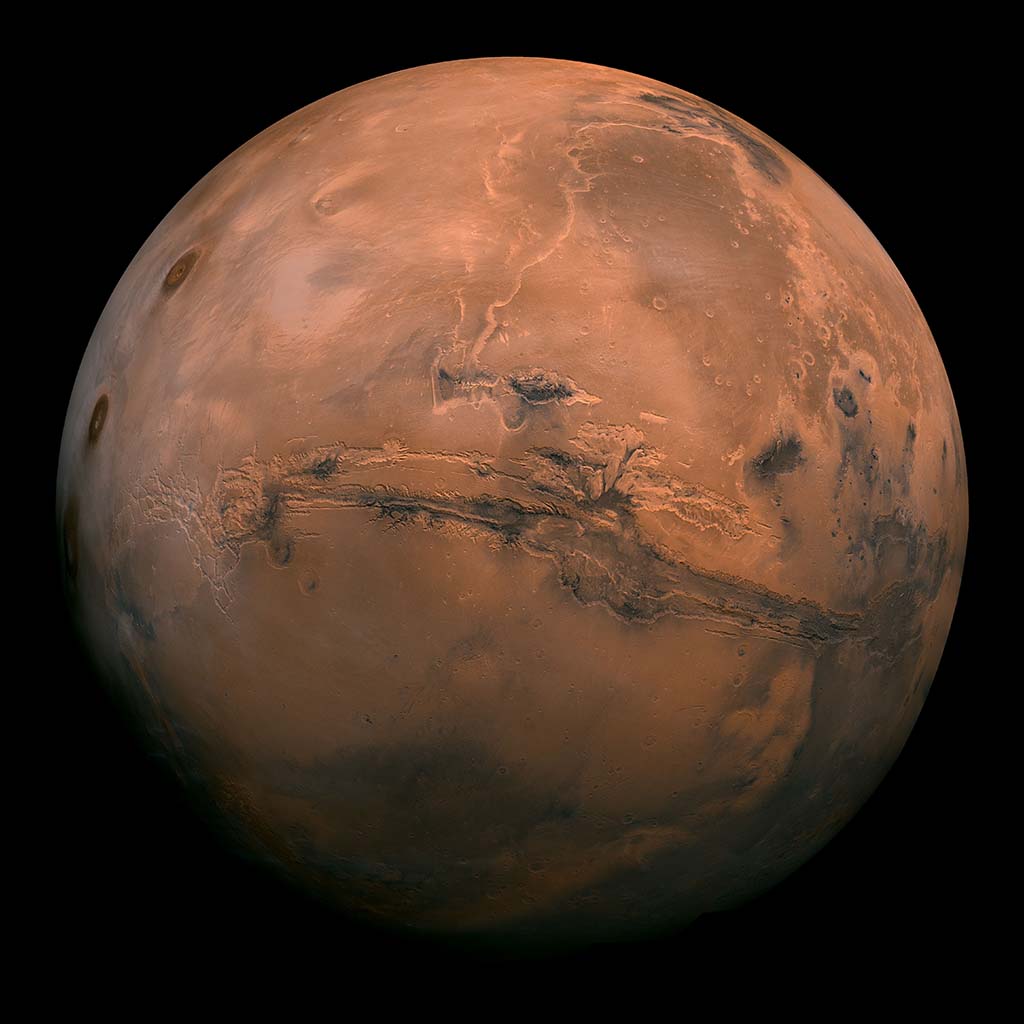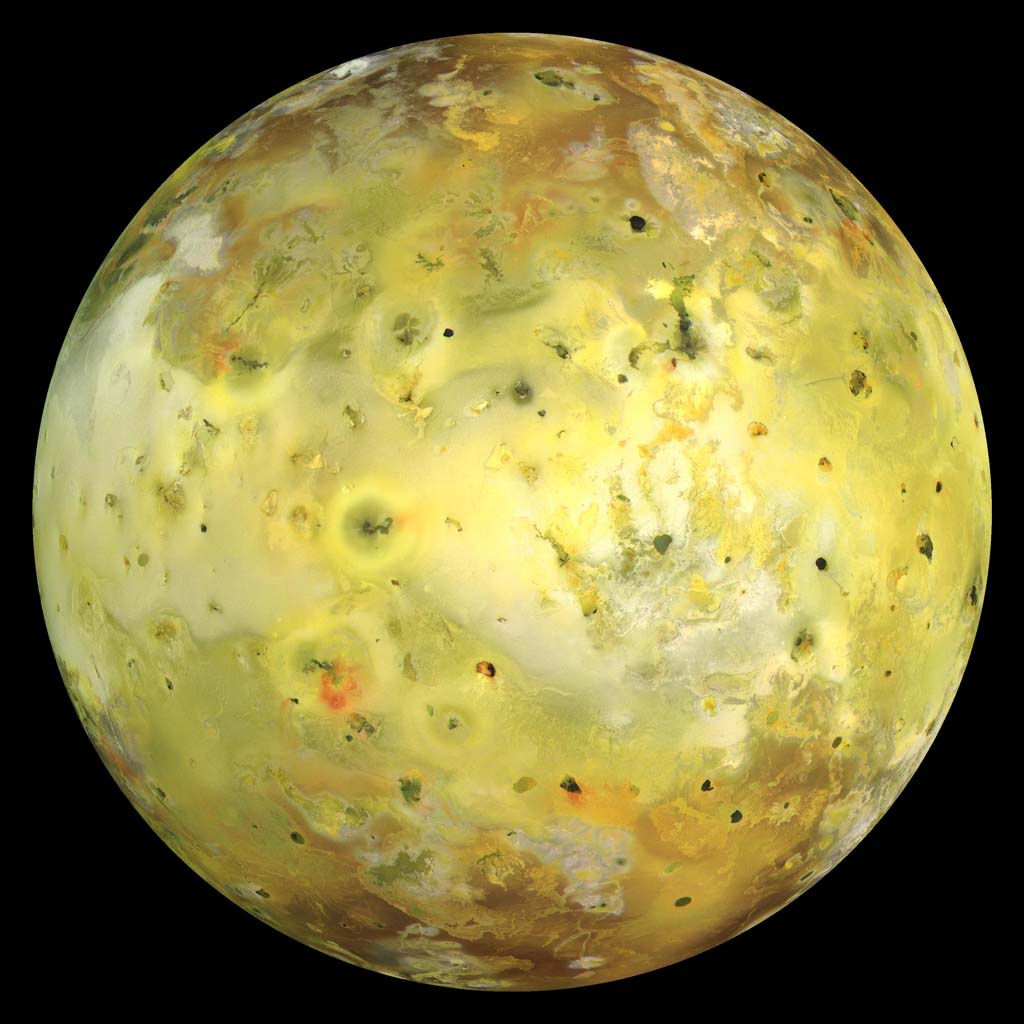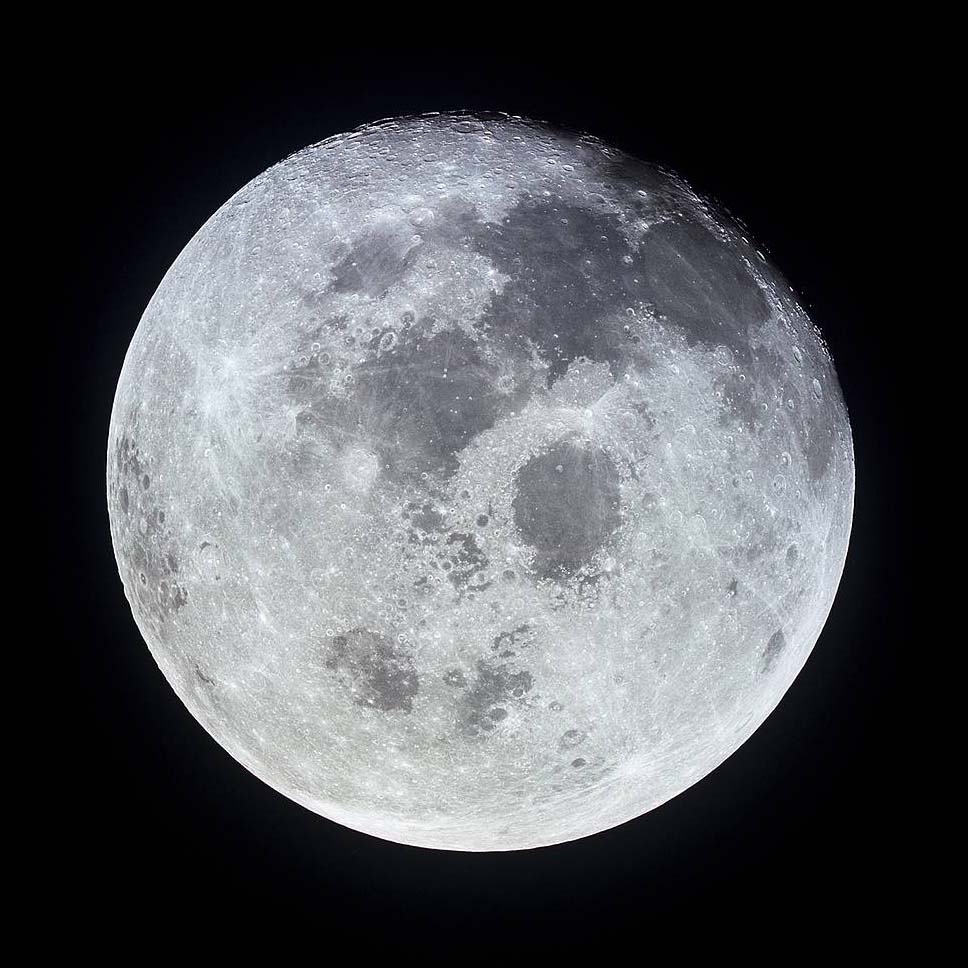Greetings, planet pickers! Welcome to Bob the Alien's Top of the Solar System! The Solar System is full of thousands of objects of various shapes and sizes - some unimaginably huge and some extremely tiny. Here is our rundown of the twenty largest items in the Solar System.

Yellow dwarf star, centre of the Solar System
Diameter: 1,392,000 kilometres / 865,000 miles

Topping our charts for what seems like an eternity
and the undisputed holder of the title of Official Largest Object in the Solar System is
everybody's favourite star, the Sun! At a width of 1,392,000 km (865,000 miles) and
weighing in at almost 2 million million million million million kilograms (whoever weighed it must
have some pretty big scales!), the Sun is large enough to contain every single other object
in the Solar System and is set to get even bigger as it gets older. It is almost ten times
wider than the next largest object in the Solar System, which is......

Gas Giant. Fifth planet from the Sun, first of
the Outer Planets
Diameter: 142,984 kilometres / 88,846 miles

By Jove, it's Jupiter! Yes, second in our chart is the Solar System's largest planet and the first of the
Gas Giants. Jupiter is a world made mostly of gas (hydrogen and helium if you're interested), hence the reason why it's called a
Gas Giant. Scientists think that it may have a solid core surrounded by liquid metallic oceans, but they don't know for sure. In fact, they're probably just guessing. It could have a chocolate centre for all they know.
Jupiter is a stormy world, with one storm in particular -
The Great Red Spot - having raged for at least three hundred years. Keeping Jupiter company are at least
93 moons. Don't be surprised if some of them pop up later in this list.

Gas Giant. Sixth planet from the Sun, second
of the Outer Planets
Diameter: 120,536 kilometres / 74,900 miles

Jupiter's not-so-near neighbour is
Saturn and it takes bronze position in this leaderboard of the Solar System's giants. Whoever or whatever created the Solar System seemed to like
Saturn so much that they put a ring on it! With a similar gassy composition to
Jupiter, Saturn also has a multitude of
moons of all shapes and sizes orbiting it. Its diameter is 120,536 kilometres (74,900 miles), but if we take into consideration its ringspan,
Saturn's diameter more than doubles to a whopping 270,000 kilometres (168,000 miles).

Gas Giant. Seventh planet from the Sun, third
of the Outer Planets
Diameter: 51,118 kilometres / 31,763 miles

Fourth on our list is the rather dull and featureless
Uranus. But what it lacks in looks, it makes up in peculiarity. At some point in its history,
Uranus fell over. Either this was because another large object collided with it and knocked it over, or it just felt like being different. Whatever happened,
Uranus appears to orbit on its side, as if it is rolling around the
Sun. Scientists are easily excitable creatures, and the effects of
Uranus' sideways orbit excites them greatly. You see, its orbit causes
Uranus to have an 'interesting' magnetic field, day and night to last forever (42 years), and its
moons to orbit up and under the planet.

Gas Giant. Eighth and most distant regular
planet from the Sun, fourth of the Outer Planets
Diameter: 49,532 kilometres / 30,779 miles

When it was discovered in 1851,
Neptune, the fifth object on our list, was the most distant planet in the Solar System. It lost its claim to this title in 1930 when
Pluto was discovered, briefly regaining it for a few years in the late 1990s due to
Pluto's weird orbit. However, when Pluto was thrown out of the Planet Gang* in 2006 and became a dwarf planet,
Neptune was once again given the title of Official Most Distant Planet in the Solar System (remember that if you're doing 'space travel brochures' kids!).
Neptune is the last of the Gas Giants, representing the end of the region of the Solar System dominated by the huge gassy worlds. It's a very cold and windy world, the windiest of all of the planets. *Note: The Planet Gang doesn't actually exist. I just made it up.

Inner Planet. Third planet from the Sun
Diameter: 12,756 kilometres / 7,926 miles

At number six is the Solar System's most unique, most special and most interesting object. It's none other than your home. Well, obviously, not your actual house, but the world on which it is situated. It's
Earth, the first object in this chart with a solid surface, and therefore the first place you can actually stand on. The presence of water on its surface, a breathable atmosphere, a suitable climate and protection from the
Sun's dangerous rays are all factors that allow
Earth to be the ideal place for life. The planet is now home to countless lifeforms, and you are of course one of them! But, take care of
Earth, because there's nowhere else to go.

Inner Planet. Second planet from the Sun
Diameter: 12,104 kilometres / 7,521 miles

With a size, mass, gravity and composition similar to
Earth, Venus is often seen as its slightly smaller twin. If it is
Earth's twin, Venus is most definitely an evil one. Something went drastically wrong with Venus at some point. If you were able to stand on its
surface, you would be crushed, suffocated, cooked and pretty much doomed. Venus' surface pressure is similar to being 1km below water on Earth. Its
atmosphere contains suffocating carbon dioxide, clouds contain sulphuric acid and temperatures are
almost 500 °C (900 °F), hot enough to melt lead. And, even if you could survive, the fact that a day on
Venus is longer than its year, and that it spins the wrong way, will just mess with your head! It's little wonder that
Venus hides it horrors under a cover of deceptively beautiful clouds.

Inner Planet. Fourth planet from the Sun
Diameter: 6,794 kilometres / 4,222 miles

Now this is more like it! Forget
Venus and its inhospitality. Mars is much more accommodating, and over the years, the Red Planet has welcomed
visitors aplenty, allowing rovers to drive across its surface, take pictures, poke its rocks and analyse its soil. Even so, it's still not somewhere that you'd go to in a hurry. With an unbreathable atmosphere, no water to drink (well, perhaps a small amount) and temperatures that are chilly to the extreme,
Mars is not really the best place for a day out. That's not to say that
life over there has been completely ruled out. Scientists continue to find evidence that suggest that
life could be or could have been possible on
Mars.

Moon of Jupiter. Eighth closest moon to
Jupiter, third of the Galilean satellites
Diameter: 5,262 kilometres / 3,270 miles

Unbelievably, the ninth and tenth largest objects in the Solar System happen to be moons. Well, I found it quite unbelievable when I found out. The Solar System's largest moon is
Ganymede which orbits the Solar System's largest planet,
Jupiter. Large enough to have been spotted by Galileo Galilei in 1610 through one of the first telescopes,
Ganymede's surface is a mixture of extremely ancient and slightly less extremely ancient. Part of it is heavily cratered, much like many moons, whereas
other parts are much smoother, suggesting that some sort of geological disturbance occurred after the period of heavy bombardment. Scientists reckon that deep below the surface, there may be water.

Moon of Saturn. Twenty-first moon in orbit of
the planet
Diameter: 5,510 kilometres / 3,200 miles

The tenth largest object in the Solar System is
Titan, the Solar System's second largest moon which orbits the Solar System's second largest planet,
Saturn. What makes Titan unique is that it is the only moon in the Solar System to possess an atmosphere. And what an atmosphere it does possess! In fact, to be able to see through it, a probe had to be send to its surface to take pictures. Images sent back from the Huygens probe which landed in 2005 - along with radar imagery from the Cassini orbiter - revealed Titan to possess lakes of liquid methane. As well as methane in its atmosphere and frozen methane on its surface, the element plays a similar role on
Titan as water does on Earth. Scientists sometimes consider
Titan to be similar to an early
Earth and some even consider the possibility of life there.

Inner Planet. Closest planet to the Sun
Diameter: 4,878 kilometres / 3,031 miles

Because we're no longer allowed to call
Pluto a planet, the final planet to feature in our chart, and therefore the smallest, is
Mercury. Whizzing around the Sun in just 88 days,
Mercury is scorched by the star on its sunlit side, yet is colder than cold on its 'night' side, its lack of atmosphere preventing the retention and dispersal of any of the heat that the planet receives.
Mercury's surface is heavily cratered, although hidden in the shadows of some of the craters at its poles is a secret stash of water. Well, it was a secret until it was found. It's likely the water came from a comet.
Mercury's surface is heavily cratered, although hidden in the shadows of some of the craters at its poles is a secret stash of water. Well, it was a secret until it was found. It's likely the water came from a comet.

Moon of Jupiter. Ninth closest moon to
Jupiter, fourth of the Galilean satellites
Diameter: 4,821 kilometres / 2,996 miles

It's back to Jupiter for now with
Callisto occupying twelfth spot in our list.
Callisto is the fourth of the Galilean satellites,
Jupiter's four largest moons discovered by Galilei in 1610.
Callisto is heavily cratered like most moons, but the rings around its craters appear quite bright suggesting that ice may be under its surface.

Moon of Jupiter. Fifth closest moon to
Jupiter, first of the Galilean satellites
Diameter: 3,643 kilometres / 2,264 miles

Io,
Io, it's off the Jupiter we go - again. The thirteenth largest object in the Solar System is
Io, Jupiter's third largest moon and the closest of the four large
Galilean satellites to orbit the planet.
Io is a violent world where volcanoes erupt on a daily basis. The insides of
Io are constantly churned and heated by the gravitational tug-of-war between
Jupiter on one side and Europa,
Ganymede and Callisto on the other. The resulting eruptions give the moon an ever-changing colourful appearance, and the discovery of active volcanoes there in 1979 revealed that
Earth isn't the only only geologically active place in the Solar System, a discovery that undoubtedly excited many scientists.

Natural satellite. In orbit of Earth
Diameter: 3,475 kilometres / 2,159 miles

Next up is a very familiar face -
Earth's Moon, or Luna if you want to give it another name. Thought to have formed out of the debris from a collision of a planet-sized object with
Earth in the early days of the Solar System, the
Moon is 400 times smaller than the Sun but, by some bizarre coincidence, is 400 times closer to
Earth than the Sun. This means that the
Moon and the Sun appear to be the same size from
Earth and that the Moon can completely cover the
Sun's disc during a total eclipse. The
Moon is the only surface other than
Earth to have been stepped on by human beings. The last one there stepped off it in 1972 but it's hoped that
humans will return to its surface in 2024.

Moon of Jupiter. Sixth closest moon to
Jupiter, second of the Galilean satellites
Diameter: 3,122 kilometres / 1,940 miles

It's back to Jupiter for the final time, and time to acquaint ourselves with
Europa. Unlike most moons, Europa's surface is smooth. This is because its surface is ice. It is thought that the ice
is as much as 30 kilometres thick (18 miles) and that below it there may be water. As you know, or you should if you've read this website properly seeing as I keep harping on about it, water is essential for life. As
Europa is thought to be covered in it, scientists are especially eager to investigate it. Who knows what kind of mysterious sea-dwelling creatures lurk in the depths of
Europa's oceans? Not me, that's for sure.

Moon of Neptune, seventh closest to the planet
Diameter: 2,707 kilometres / 1,680 miles

It's over to Neptune now as its largest moon,
Triton, takes sixteenth spot on our list.
Triton is a cold, lonely place (well, I suppose everywhere other than
Earth is lonely), so to pass the time and amuse itself,
Triton orbits backwards and sometimes emits gasses. Nitrogen gas escapes through geysers in a similar, but less exciting, way to the volcanoes on
Io. What this proves is that even distant moons are geologically active.

Dwarf planet/Trans-Neptunian Object/Kuiper Belt Object/Plutoid. Usually orbits beyond Neptune
Diameter: 2,370 kilometres / 1,473 miles

Pluto was discovered in 1930 by Clyde Tombaugh who was looking for a large planet beyond Neptune that was affecting Uranus' orbit. It later became apparent Uranus' orbit was not actually being affected by anything beyond Neptune, so Pluto's discovery was more through pure luck than anything else. Pluto's name was suggested by an English schoolgirl. Pluto was once considered to be the ninth planet in the Solar System but was reclassified in 2006 as a dwarf planet following the discovery of Eris a few years earlier. For a while it was thought that Eris was actually larger than Pluto, but a recent remeasurement reveals that it wasn't. Good news for Pluto, bad news for me as I've had to shuffle this chart around.

Dwarf planet/Trans-Neptunian Object/Kuiper Belt Object/Plutoid. Most distant dwarf planet in Solar System
Diameter: 2,326 kilometres / 1,445 miles
The newest entry in our chart, Eris' discovery in 2003 gave scientists headaches and many sleepless nights, resulting in catastrophe for Pluto. Being large and round, Eris, by definition, should have been a planet. But, astronomers around the world didn't want Eris to be a planet for reasons best explained elsewhere (here for example!) so they voted to change the definition of a planet. A new definition - the dwarf planet - was created for worlds just like Eris, would-be planets that exist in regions shared with other objects. Eris became one of the first dwarf planets. But so did poor old Pluto, which lost its status as a planet.

Moon of Uranus, seventeenth closest moon to
the planet
Diameter: 1,578 kilometres / 982 miles

Titania is a moon of Uranus and the largest moon to orbit the planet. It
was discovered by William Herschel, the astronomer who discovered
Uranus itself and another of its
moons. That other moon is Oberon, which would be the 21st object on this list. Not a lot is known about Titania. It is half ice and half rock and orbits above and below
Uranus due to Uranus travelling around the
Sun on its side.

Moon of Saturn, twentieth closest moon to the
planet
Diameter: 1,530 kilometres / 949 miles

Taking last spot in our list of the Solar System's largest objects is Rhea, the second largest moon of
Saturn. It was discovered in 1672 by Giovani Domonico Cassini, although didn't get its name until 1847. Rhea is heavily cratered, and is home to a crater nicknamed "The Splat."





